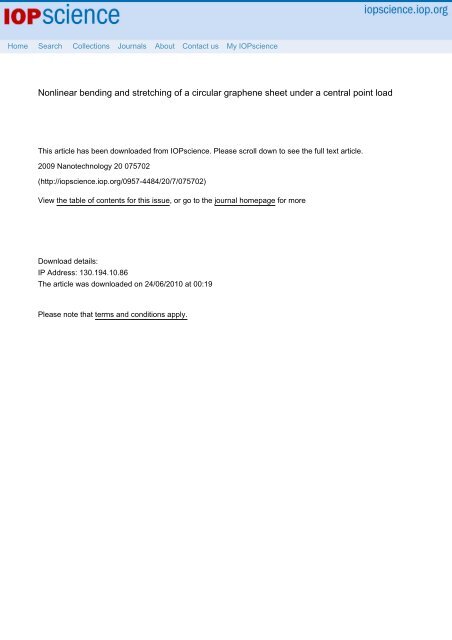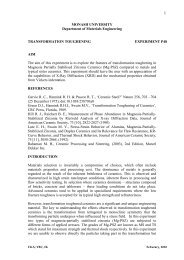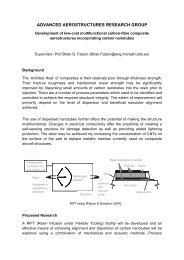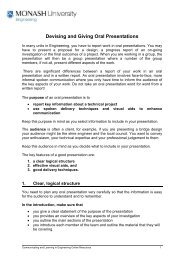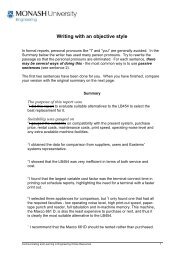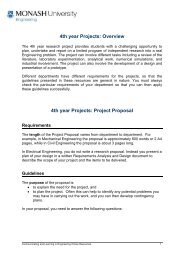Nonlinear bending and stretching of a circular graphene sheet ...
Nonlinear bending and stretching of a circular graphene sheet ...
Nonlinear bending and stretching of a circular graphene sheet ...
Create successful ePaper yourself
Turn your PDF publications into a flip-book with our unique Google optimized e-Paper software.
Home Search Collections Journals About Contact us My IOPscience<strong>Nonlinear</strong> <strong>bending</strong> <strong>and</strong> <strong>stretching</strong> <strong>of</strong> a <strong>circular</strong> <strong>graphene</strong> <strong>sheet</strong> under a central point loadThis article has been downloaded from IOPscience. Please scroll down to see the full text article.2009 Nanotechnology 20 075702(http://iopscience.iop.org/0957-4484/20/7/075702)View the table <strong>of</strong> contents for this issue, or go to the journal homepage for moreDownload details:IP Address: 130.194.10.86The article was downloaded on 24/06/2010 at 00:19Please note that terms <strong>and</strong> conditions apply.
Nanotechnology 20 (2009) 075702W H Duan <strong>and</strong> C M Wangbe scaled to W 0 /P ∝ 1/λ 2 . As for the transition between plate<strong>and</strong> membrane behavior in the range <strong>of</strong> 0.5 < λ < 1, thecentral deflection is given byW 0P = 1 ( 12πλ 2 λI 1 (λ) [1 − I 0(λ)][1 − λK 1 (λ)])+ K 0 (λ) + ln(λ/2) + γ , (11)where the Euler’s constant γ is approximately 0.5772, <strong>and</strong> itsanalytical expression is given by( ∑)1γ = limn→∞ i − ln n . (12)i=1···n3.3. Slope <strong>and</strong> curvature variations near the central region<strong>and</strong> edge zoneIn section 3.2, it is concluded that <strong>stretching</strong> generallydominates the <strong>graphene</strong> <strong>sheet</strong> deflection. In this section, wewill explore the <strong>bending</strong> effect in the central region <strong>and</strong> edgezone. Figure 4 shows the variation <strong>of</strong> the slope with respectto the non-dimensional radius η for λ = 15.94 based on MMsimulations. Interestingly, the results from the MM simulationsshow that the slope <strong>of</strong> the <strong>graphene</strong> <strong>sheet</strong> has a singularityin the vicinity <strong>of</strong> the central point. The <strong>graphene</strong> <strong>sheet</strong>behaves nonlinearly in this vicinity, whereas it behaves linearlyelastically further away from the central region, as shown insection 3.2. Owing to the discrete distribution <strong>of</strong> carbon atomsin the <strong>graphene</strong> <strong>sheet</strong>, the sharp variation <strong>of</strong> the slope aroundcentral region is difficult to show by MM simulations. Again,we can use the Kirchh<strong>of</strong>f plate theory to examine the slope <strong>and</strong>curvature variations near the central region <strong>and</strong> edge zone as itcan be treated analytically.We first introduce the large value approximation for themodified Bessel functions, namely [32]lim I β(x) = √ ex, <strong>and</strong>x→∞ 2πx√ πlim K β(x) = e −xx→∞ 2x . (13)Based on this approximation, equation (9) furnishes, for largeλ,θ(η) =P ( √e −λη λπ2πλ 2 2η + e−λ(1−η)√ − 1 ). (14)η ηThis equation indicates √ a small exponential central region(corresponding to e −λη λπ) <strong>and</strong> edge (corresponding to2ηe −λ(1−η)√ η) corrections to the pure membrane case to accommodatethe zero slope condition at η = 0 <strong>and</strong> 1. This results in largecurvature changes which can be explained from equation (10).For large λ, the maximum curvature term at the edge isobtained as ϕ(1) = P/(2πλ), while the curvature term ϕ(0)approaches infinity due to the ln(λη/2) term in equation (10).These two values are considerably greater than the membranecurvature ϕ(η) = P/(2πλ 2 ) at the middle portion <strong>of</strong> the<strong>circular</strong> <strong>graphene</strong> <strong>sheet</strong>. Physically, this indicates the presence<strong>of</strong> a stress concentration in the central region <strong>and</strong> the edgezone. In order to reduce the stress concentration, the substrateFigure 4. Slope variation in the central region <strong>and</strong> edge zone for a<strong>circular</strong> <strong>graphene</strong> <strong>sheet</strong> with 4 nm radius: the initial in-plane tensionis set to be λ = 15.94; the corresponding initial length <strong>of</strong> the carbonbond is 0.0140 nm.supporting the <strong>graphene</strong> <strong>sheet</strong> should be as thin as possible aswell as relatively s<strong>of</strong>ter, so that the boundary condition canbe simulated as a simply supported edge. The curvature <strong>of</strong> a<strong>circular</strong> <strong>graphene</strong> <strong>sheet</strong> for the simply supported edge is givenbyϕ(η) = P2π( 1λ 2 η − K 0(λη) − K 1(λη)2 λη− (1 − ν)(1 − λK 1(λ)) − λ 2 K 0 (λ)λ[λI 0 (λ)−(1−ν)I 1 (λ)](I 0 (λη)− I ))1(λη).λη(15)By using a similar analysis for the clamped <strong>graphene</strong> <strong>sheet</strong>, onecan obtain ϕ(1) = ν P/(2πλ 2 ), which has the same scale forin-plane tension λ, at the middle part <strong>of</strong> the <strong>circular</strong> <strong>graphene</strong><strong>sheet</strong>. Therefore the stress concentration may be reduced oravoided. As for the stress concentration near the central point,it can be easily reduced by spreading the area <strong>of</strong> the loadapplication.4. Assessment <strong>of</strong> continuum mechanics model for theanalysis <strong>of</strong> <strong>graphene</strong> <strong>sheet</strong>sThe analysis in section 3 shows that the von Kármán platetheory is able to furnish results that are in reasonable agreementwith MM simulation results. Although it still needs somenumerical computations, it is faster than performing MMsimulations. Kirchh<strong>of</strong>f’s theory can be used as a quick <strong>and</strong>rough approximation, particularly for small deflections, asthey can be treated analytically. In order to quantitativelydemonstrate the accuracy <strong>of</strong> the continuum mechanics modelfor the analysis <strong>of</strong> <strong>graphene</strong> <strong>sheet</strong>s, the point load P values fora given central deflection value W 0 for <strong>graphene</strong> <strong>sheet</strong>s with4 nm radius <strong>and</strong> 10 nm radius obtained from MM simulationsare compared to the Kirchh<strong>of</strong>f plate <strong>and</strong> the von Kármán plateresults in table 1. It can be seen that, for small deflections, theresults from the Kirchh<strong>of</strong>f plate theory <strong>and</strong> the von Kármánplate theory are in close agreement with the MM results. For5
Nanotechnology 20 (2009) 075702W H Duan <strong>and</strong> C M WangTable 1. Comparison <strong>of</strong> point load P magnitudes obtained from Kirchh<strong>of</strong>f plate theory <strong>and</strong> von Kármán plate theory with respect to MMsimulations for given central deflection W 0 <strong>and</strong> in-plane tensile stress λ (Poisson ratio ν = 0.16).λ W 0 MM (a)Based on Kirchh<strong>of</strong>fplate theory (b)Point load PDiff(%) =| (b)−(a)(a)|×100Circular <strong>graphene</strong> <strong>sheet</strong> with radius a = 4nmBasedonvonKármánplate theory (c)15.94 0.0050 3.141 3.085 1.78 3.100 1.300.0075 4.767 4.627 2.98 4.678 1.870.0500 46.56 30.85 33.8 43.50 6.570.0750 95.03 46.27 51.3 85.35 10.20.1250 282.2 77.11 72.7 240.1 14.935.25 0.0050 11.57 11.42 1.35 11.45 1.090.0250 60.90 57.10 6.24 59.90 1.650.0500 137.1 114.2 16.7 133.3 2.770.1250 527.4 285.5 45.9 493.4 6.440.2000 1280 456.8 64.3 1170 8.62Circular <strong>graphene</strong> <strong>sheet</strong> with radius a = 10 nm39.85 0.0050 14.48 14.08 2.76 14.25 1.590.0200 66.79 56.32 15.7 64.74 3.070.0250 88.78 70.40 20.7 85.59 3.600.0550 292.4 154.9 47.0 268.8 8.060.0950 854.8 267.5 68.7 739.6 13.6Diff(%) =| (c)−(a)(a)|×100example, for in-plane tension <strong>of</strong> λ = 15.94 <strong>and</strong> for a givenW 0 = 0.005, the percentage differences between load valuesfrom MM simulation are 1.78% <strong>and</strong> 1.30% for Kirchh<strong>of</strong>f platetheory <strong>and</strong> von Kármán plate theory, respectively. Thesepercentages reduce to 1.35% <strong>and</strong> 1.09% when the in-planetension is increased to λ = 35.25 due to even smallerdeflections. When the central deflection is increased to, say,W 0 = 0.05, the percentage differences between the loads areincreased to 33.8% <strong>and</strong> 6.57% for λ = 15.94 <strong>and</strong> 16.7% <strong>and</strong>2.77% for λ = 35.25. It is clear that the Kirchh<strong>of</strong>f platesolution is no longer accurate for this larger deflection case.The above trends in the results are also valid for the larger<strong>circular</strong> <strong>graphene</strong> <strong>sheet</strong> <strong>of</strong> radius 10 nm, as shown in table 1.In summary, when deflections are small, one can use theKirchh<strong>of</strong>f plate theory or the von Kármán plate theory to modelthe <strong>graphene</strong> <strong>sheet</strong>, <strong>of</strong> course with the appropriate thickness<strong>and</strong> material properties. When the deflections are moderatelylarge, the Kirchh<strong>of</strong>f plate theory under-predicts the load. Inthe case <strong>of</strong> large deflections, the von Kármán plate theory isthe only plate theory that could give reasonably good results,but this theory also fails in providing accurate results when the<strong>graphene</strong> <strong>sheet</strong> undergoes extremely large deflections. In suchcase, only MM simulations can predict the results accurately atthis stage <strong>of</strong> computational modeling.5. ConclusionsMM simulations show that <strong>graphene</strong> <strong>sheet</strong>s have remarkable<strong>bending</strong> <strong>and</strong> <strong>stretching</strong> properties, being able to sustainrelatively large in-plane strains before fracture. It is worthnoting that although the <strong>stretching</strong> is dominant in <strong>graphene</strong>deflection for a large in-plane tension, the <strong>bending</strong> effectalways exists in the central region <strong>and</strong> edge zone. This <strong>bending</strong>effect over a small zone causes stress concentrations, whichmay be reduced by a thinner <strong>and</strong> s<strong>of</strong>ter supporting substrate.The peculiar behavior beyond the small deflection assumptioncan be well described by the von Kármán plate theory. Bycomparing with MM simulation results, we found that, byassuming the Poisson ratio ν = 0.16, the Young’s modulusY = 6.88 TPa, <strong>and</strong> the thickness h = 0.052 nm for a <strong>graphene</strong><strong>sheet</strong> modeled as a plate. The spring constant <strong>of</strong> a <strong>graphene</strong><strong>sheet</strong> is estimated to be about 9.85 N m −1 without the presence<strong>of</strong> in-plane tension. This constant could be raised further in thepresence <strong>of</strong> initial in-plane tensile forces.References[1] de Parga A L V, Calleja F, Borca B, Passeggi M C G,Hinarejos J J, Guinea F <strong>and</strong> Mir<strong>and</strong>a R 2008 Periodicallyrippled <strong>graphene</strong>: growth <strong>and</strong> spatially resolved electronicstructure Phys. Rev. Lett. 1 4[2] Barzola-Quiquia J, Esquinazi P, Rothermel M, Spemann D,Butz T <strong>and</strong> Garcia N 2007 Experimental evidence fortwo-dimensional magnetic order in proton bombardedgraphite Phys. Rev. B 76 4[3] Novoselov K S, Geim A K, Morozov S V, Jiang D, Zhang Y,Dubonos S V, Grigorieva I V <strong>and</strong> Firsov A A 2004 Electricfield effect in atomically thin carbon films Science306 666–9[4] Novoselov K S, Jiang Z, Zhang Y, Morozov S V, Stormer H L,Zeitler U, Maan J C, Boebinger G S, Kim P <strong>and</strong> Geim A K2007 Room-temperature quantum hall effect in <strong>graphene</strong>Science 315 1379[5] Peter W S, Jan-Ingo F <strong>and</strong> Eli A S 2008 Epitaxial <strong>graphene</strong> onruthenium Nat. Mater. 7 406–11[6] Dutta S, Lakshmi S <strong>and</strong> Pati S K 2008 Electron–electroninteractions on the edge states <strong>of</strong> <strong>graphene</strong>: a many-bodyconfiguration interaction study Phys. Rev. B 77 4[7] Lai Y H, Ho J H, Chang C P <strong>and</strong> Lin M F 2008Magnetoelectronic properties <strong>of</strong> bilayer Bernal <strong>graphene</strong>Phys. Rev. B 77 10[8] Lherbier A, Biel B, Niquet Y M <strong>and</strong> Roche S 2008 Transportlength scales in disordered <strong>graphene</strong>-based materials: strong6
Nanotechnology 20 (2009) 075702localization regimes <strong>and</strong> dimensionality effects Phys. Rev.Lett. 1 4[9] Chiu Y H, Lai Y H, Ho J H, Chuu D S <strong>and</strong> Lin M F 2008Electronic structure <strong>of</strong> a two-dimensional <strong>graphene</strong>monolayer in a spatially modulated magnetic field: Peierlstight-binding model Phys. Rev. B 77 6[10] Meyer J C, Geim A K, Katsnelson M I, Novoselov K S,Booth T J <strong>and</strong> Roth S 2007 The structure <strong>of</strong> suspended<strong>graphene</strong> <strong>sheet</strong>s Nature 446 60–3[11] Geim A K <strong>and</strong> Novoselov K S 2007 The rise <strong>of</strong> <strong>graphene</strong>Nat. Mater. 6 183–91[12] Schedin F, Geim A K, Morozov S V, Hill E W, Blake P,Katsnelson M I <strong>and</strong> Novoselov K S 2007 Detection <strong>of</strong>individual gas molecules adsorbed on <strong>graphene</strong> Nat. Mater.6 652–5[13] Bunch J S, van der Z<strong>and</strong>e A M, Verbridge S S, Frank I W,Tanenbaum D M, Parpia J M, Craighead H G <strong>and</strong>McEuen P L 2007 Electromechanical resonators from<strong>graphene</strong> <strong>sheet</strong>s Science 315 490–3[14] Fasolino A, Los J H <strong>and</strong> Katsnelson M I 2007 Intrinsic ripplesin <strong>graphene</strong> Nat. Mater. 6 858–61[15] Carlsson J M 2007 Graphene: buckle or break Nat. Mater.6 801–2[16] Frank I W, Tanenbaum D M, Van der Z<strong>and</strong>e A M <strong>and</strong>McEuen P L 2007 Mechanical properties <strong>of</strong> suspended<strong>graphene</strong> <strong>sheet</strong>s J. Vac. Sci. Technol. B 25 2558–61[17] Poot M <strong>and</strong> van der Zant H S J 2008 Nanomechanicalproperties <strong>of</strong> few-layer <strong>graphene</strong> membranes Appl. Phys.Lett. 92 063111[18] He X Q, Kitipornchai S <strong>and</strong> Liew K M 2005 Resonanceanalysis <strong>of</strong> multi-layered <strong>graphene</strong> <strong>sheet</strong>s used as nanoscaleresonators Nanotechnology 16 2086–91[19] Kitipornchai S, He X Q <strong>and</strong> Liew K M 2005 Continuum modelfor the vibration <strong>of</strong> multilayered <strong>graphene</strong> <strong>sheet</strong>s Phys. Rev.B 72 075443W H Duan <strong>and</strong> C M Wang[20] Xu X <strong>and</strong> Liao K 2001 Mater. Phys. Mech. 4 148[21] L<strong>and</strong>au L D <strong>and</strong> Lifshits E M 1970 Theory <strong>of</strong> Elasticity(New York: Pergamon Press)[22] L<strong>and</strong>man U, Luedtke W D, Burnham N A <strong>and</strong> Colton R J 1990Atomistic mechanisms <strong>and</strong> dynamics <strong>of</strong> adhesion,nanoindentation, <strong>and</strong> fracture Science 248 454–61[23] Rigby D, Sun H <strong>and</strong> Eichinger B E 1997 Computer simulations<strong>of</strong> poly(ethylene oxide): force field, PVT diagram <strong>and</strong>cyclization behaviour Polym. Int. 44 311–30[24] Duan W H, Wang Q, Liew K M <strong>and</strong> He X Q 2007 Molecularmechanics modeling <strong>of</strong> carbon nanotube fracture Carbon45 1769–76[25] Wang Q, Duan W H, Liew K M <strong>and</strong> He X Q 2007 Inelasticbuckling <strong>of</strong> carbon nanotubes Appl. Phys. Lett. 90 033110[26] Cao G X <strong>and</strong> Chen X 2006 Mechanisms <strong>of</strong> nanoindentation onsingle-walled carbon nanotubes: the effect <strong>of</strong> nanotubelength J. Mater. Res. 21 1048–70[27] Libai A <strong>and</strong> Simmonds J G 1988 The <strong>Nonlinear</strong> Theory <strong>of</strong>Elastic Shells: One Spatial Dimension (Boston: Academic)[28] Komaragiri U <strong>and</strong> Begley M R 2005 The mechanical response<strong>of</strong> freest<strong>and</strong>ing <strong>circular</strong> elastic films under point <strong>and</strong>pressure loads Trans. ASME, J. Appl. Mech. 72 203–12[29] Sheplak M <strong>and</strong> Dugundji J 1998 Large deflections <strong>of</strong> clamped<strong>circular</strong> plates under initial tension <strong>and</strong> transitions tomembrane behavior Trans. ASME, J. Appl. Mech. 65 107–15[30] Yakobson B I, Brabec C J <strong>and</strong> Bernholc J 1996 Nanomechanics<strong>of</strong> carbon tubes: instabilities beyond linear response Phys.Rev. Lett. 76 2511–4[31] Shampine L F, Gladwell I <strong>and</strong> Thompson S 2003 Solving ODEswith MATLAB (Cambridge: Cambridge University Press)[32] Abramowitz M <strong>and</strong> Stegun I A 1972 H<strong>and</strong>book <strong>of</strong>Mathematical Functions with Formulas, Graphs, <strong>and</strong>Mathematical Tables (Washington, DC: US Govt. PrintingOffice)7


